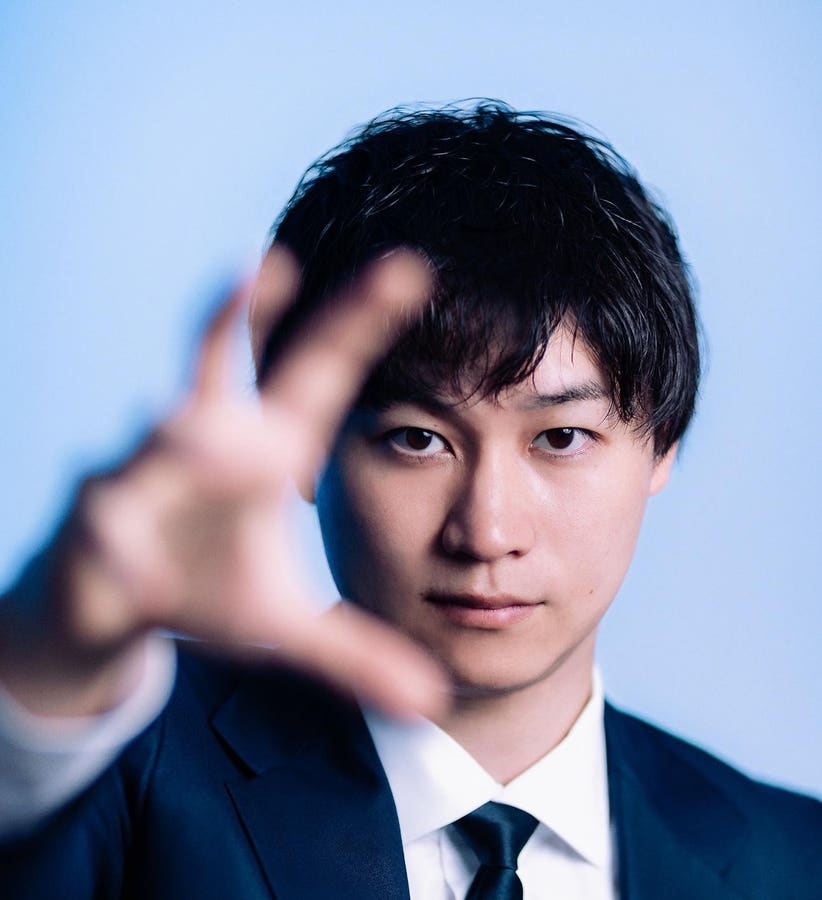Shunsaku Sagami, founder and CEO of Tokyo-listed M&A Research Institute, leveraged AI to give his M&A business a competitive edge. Now the 33-year-old is looking to replicate the success abroad.
As an avid Mahjong player, Shunsaku Sagami deploys skills such as risk assessment, careful observation and strategic thinking to beat his opponents, not dissimilar to his approach to business. The entrepreneur rolled the dice six years ago when he launched his mergers and acquisitions brokerage firm aimed at Japan’s small and midsized companies, many of which have older owners and lack successors. Sagami wasn’t the first to target a segment that the big banks had shunned, but he has proved to be a disruptor in a market dominated by entrenched rivals.
Today, the 33-year-old’s M&A Research Institute Holdings is one of Japan’s top four listed SME M&A firms by market cap and is outstripping its three competitors—Nihon M&A Center, Strike and M&A Capital Partners—in terms of earnings growth and number of successful transactions per advisor. It almost doubled the number of M&A deals it closed in the six months ended March 31, to 123, compared with 333 deals at Nihon M&A Center; 130 at Strike; and 96 by M&A Capital Partners.
The company’s shares were on a tear since its 2022 listing in Tokyo, rising fourfold until April 2023, when Sagami became a billionaire based on his then-73% stake. He retains that status as we go to press, even though his holding has since been reduced to 53% due to secondary share offerings by the firm and his decision to sell some stock in March, which, as per a company filing, was aimed at improving liquidity.
M&A Research Institute’s competitive edge is based on an AI algorithm for matching sellers with buyers, proprietary software for digitizing paperwork, a simplified fee structure and aggressive hiring. “I don’t think our business model itself is that brilliant,” CEO Sagami says at his headquarters in the bustling Marunouchi business district of Tokyo in May. But, he adds, “We’ve developed an overwhelmingly strong system that is difficult for competitors to imitate.”
The workflow software, for example, has gone through “over 10,000 iterations,” making it “absolutely impossible” for competitors—many of which still carry out administrative work manually—to catch up, says Sagami, a self-taught software engineer. As a result, M&A Research Institute says it can close a deal in just under seven months on average. That compares with the SME M&A industry average of 10-12 months, according to Tokyo-based Macquarie analyst Shinji Tanioka in an email. Likewise, each of its advisors closes roughly twice as many deals a year as their rivals, Tanioka says. In a 2023 report, the analyst wrote that the company’s use of data to improve productivity “is revolutionizing the labor-intensive process of M&A sourcing and execution.”
SOURCE: MACQUARIE RESEARCH
Part of the company’s growth also stems from aggressive hiring. Sagami expanded his team of advisors by a third to 242 in the six months through March, and he plans to nearly triple that to 700 by the end of September 2026. By comparison, Nihon M&A Center had 645 advisors as of March 31; Strike, 241; and M&A Capital Partners, 187, according to their respective earnings reports.
M&A Research Institute identifies sellers, then the AI algorithm matches them with potential buyers in the firm’s private database. The advisors, who, as is typical in SME M&A deals, represent both seller and buyer, negotiate and complete the transaction.
Sagami targets companies with up to ¥500 million ($3 million) in revenue, accounting for more than two-thirds of all his completed transactions through March. More than half came from the manufacturing, construction, information technology, and wholesale and retail sectors. Past deals include the sale of a ¥200 million (revenue) IT company with no successor to a ¥15 billion (revenue) rival.
The company’s use of data to improve productivity “is revolutionizing the labor-intensive process of M&A sourcing and execution.”
M&A Research Institute’s deal-making growth is partly attributed to another unique selling point: It only charges a fee once a deal has been completed, unlike its competitors, most of which charge start up, interim and other fees. M&A Research Institute applies fees to both the buyer and seller. The fee percentage varies, depending on deal size and other factors. For example, for transactions of over ¥200 million to ¥500 million, it’s 5% for the buyer. For the seller, for a deal of ¥500 million or less, the fee is variable, but they pay a minimum of ¥25 million.
Japan’s SME sector accounts for 99.7% of all companies and about two-thirds of jobs, according to government data. Such companies are crucial to manufacturing supply chains, providing key inputs for industries ranging from chips and electronics to automobiles. Japan’s definition of an SME varies depending on the sector. One designation is companies with a maximum of ¥300 million in capital, or up to 300 permanent employees, but the thresholds are typically higher for manufacturers and lower for service providers and retailers.
Deals involving SMEs whose owners are grappling with succession will double to more than ¥500 billion in total by 2033, Tokyo-based JPMorgan analysts Ami Terai and Haruka Mori wrote in a report in March. They estimate annual transactions will surge to nearly 10,000 from 4,000 in the same period. More than a third of Japan’s 3.4 million SMEs risk closing because their owners are over 60 and don’t have anyone in the family to carry on the business, they said, adding that at least half of those businesses are profitable. “It’s an incredibly huge social issue,” Sagami notes.
Shunsaku Sagami, founder and CEO of M&A Research Institute.
SHUNICHI ODA FOR FORBES ASIA
Although revenue and net profit growth have slowed since the company’s heady early days—partly due to rising non-operating costs and the loss of certain tax breaks—they doubled to ¥8.6 billion and ¥2.6 billion, respectively, in the year ended Sept. 30, 2023. That marks the strongest growth among the top four listed firms. Sagami is confident that both sales and net profit will almost double again in the current fiscal year. The JPMorgan analysts predict revenue could reach almost ¥43 billion by end-September 2026.
Japan’s SME M&A boom is likely to continue, fueled by the country’s low birth rate and a younger generation less interested in taking over the family trade. Businesses that resolved the succession issue via M&A accounted for just over 20% of all SME successions in 2023, up from 17% in 2018, according to a November survey by Tokyo-based credit research agency Teikoku Databank.
However, Sagami and his competitors now face a challenge in the form of increased oversight of the industry. On June 9, a report in the Japanese magazine Facta claimed the government would seek to reduce brokers’ fees. That sparked a share sell-off among the top four listed SME M&A brokers, including a one-day 12% drop in M&A Research Institute; its shares have since recovered.
The company declined to comment directly on the Facta report, which came days before the government confirmed revisions to M&A guidelines to make fees more transparent and improve post-merger integration, and new state policies to promote easier sales for business succession. The regulations are expected to be finalized later this year, with fee-disclosure rules taking effect around April 2025, according to a Nikkei report in late May.
In an email, a spokesperson said the company did “not anticipate the sudden implementation of regulations that would pose unforeseeable and challenging compliance requirements.” Although there might be changes in the management of brokerage operations, the spokesperson wrote, the company did not expect any major impact on its performance. (There are almost 650 specialized M&A brokerages in Japan and some 2,000 other companies also involved in the industry, but only the top six firms have more than 100 advisors, and most have less than 10, according to the Small and Medium Enterprise Agency.)
SOURCE: COMPANY EARNINGS REPORT/ BLOOMBERG
Meanwhile, the young disruptor is forging ahead: “Aiming to be No. 1 [by operating profit] in the industry is something we naturally have to strive for,” Sagami explains, “but what we really want to do…is change legacy industries through technology.” (M&A Research Institute’ operating profit was ¥4.6 billion in fiscal 2023. It was No. 4 among its listed rivals.) Last year he set up a unit to advise companies on harnessing technology to improve efficiencies. He also launched an asset-management consultancy to support clients who have sold their businesses and need help investing the proceeds. Sagami declines to provide earnings goals for the new businesses.
Sagami is also looking overseas, helping local companies to expand abroad and aiding international companies to enter Japan. About a year ago, M&A Research Institute started to broker deals for U.S. and Southeast Asian SMEs seeking Japanese buyers. Businesses listed for sale on its website include a Singapore steak house and a solar-panel installation company in Hawaii. Sagami wouldn’t give targets for the cross-border business, but Nihon M&A Center and M&A Capital Partners had global transactions accounting for 2.4% and 7.6% of total deals, respectively, in their most recent fiscal years.
Sagami’s expansion seems well-timed. Japanese outbound M&A jumped more than 45% to $66 billion in 2023 from a year earlier, while that of inbound deals more than tripled to $30 billion, according to Dealogic. That contrasts sharply with the rest of Asia, where combined cross-border transactions rose 7%, according to the U.K. financial data provider. The international deal flurry is likely to persist for at least the next few years, notes Takashi Ohara, a Tokyo-based partner at U.S. consultancy Bain, thanks to Japanese companies’ strong balance sheets, their need to diversify beyond a shrinking home market, and rock-bottom domestic interest rates.
“In theory, M&A Research Institute could replicate the success they’ve achieved domestically to cross-border deals,” says Timothy Morse, founding partner of Hong Kong- and Singapore-based equity advisory firm Asymmetric Advisors. “Most Asian countries have aging populations, which means there’ll be an increasing number of companies that might be open to being bought out.”
“We’ve developed an overwhelmingly strong system that is difficult for competitors to imitate.”
Sagami took a roundabout way into M&A. While studying at Kobe University’s faculty of agriculture, he taught himself computer coding. After graduating in 2013, he joined Japanese advertising firm MicroAd as a software engineer and gained marketing experience. Two years later, he started a fashion media outfit called Alpaca that he sold in 2017 to Tokyo-based public relations agency Vector for about ¥950 million.
“Coming from a background in design, engineering and marketing, I understand all aspects of a business,” says Sagami, adding, “When I started running a business at a young age, I felt that unless I had a grasp of all those areas, it would be difficult for people to follow me.”
Sagami’s personal experiences informed his decision to plunge into SME M&A. He observed how his grandfather, then in his 80s, was compelled to shutter his real estate business as Sagami’s father, a police officer, wasn’t interested in taking over the company. Later, when Sagami sold his own startup and worked for Vector overseeing M&A transactions, he got a close look at the laborious paperwork, lengthy matching process and opaque fees involved in M&A deals.
Sagami remains inspired by Mahjong, in which he is pursuing pro-level certification, because “reading a situation, the give and take, they’re skills that are transferable to running a company,” he says. “As a young entrepreneur, I feel like I can rack up some more wins in the future.”



